
Simon the Sorcerer is a 1993 point-and-click adventure game developed and published by Adventure Soft, for Amiga and MS-DOS. The game's story focuses on a boy named Simon who is transported into a parallel universe of magic and monsters, where he embarks on a mission to become a wizard and rescue another from an evil sorcerer. The game's setting was inspired by the novels of the Discworld series, and incorporates parodies on fantasy novels and fairy tales, such as The Lord of the Rings and Jack and the Beanstalk. The lead character's design was inspired by that of the fictional British television character Blackadder, with the character voiced by Chris Barrie in the CD re-release.

Leisure Suit Larry is an adult-themed sex comedy video game series created by Al Lowe. Drawing inspiration from Softporn Adventure, the Leisure Suit Larry series centers on Larry Laffer—a middle-aged man known for his balding head, penchant for double entendre, and iconic leisure suits. The stories typically focus on his unsuccessful attempts to seduce young women, portraying him as an unsuccessful pickup artist. A common link between the games are Larry's explorations of luxurious and cosmopolitan hotels, ships, beaches, resorts, and casinos.

Leisure Suit Larry: Love for Sail! is an adventure game originally developed and published by Sierra On-Line in 1996. It was the sixth and last Leisure Suit Larry game written by series creator Al Lowe, and the last to feature original protagonist Larry Laffer as the main character until the release of Leisure Suit Larry: Wet Dreams Don't Dry in 2018. It followed the 1993 Leisure Suit Larry 6: Shape Up or Slip Out!.
Police Quest is a series of police simulation video games produced and published by Sierra On-Line between 1987 and 1998. The first five were adventure simulation games, the first three of which were designed by former police officer Jim Walls. The fourth to sixth titles were designed by former LAPD Chief Daryl F. Gates. Both SWAT and the real-time tactics game SWAT 2 still carried the Police Quest name and were numbered V and VI in the series, respectively, although subsequent titles in the series would drop the Police Quest title altogether and were rebranded as SWAT.
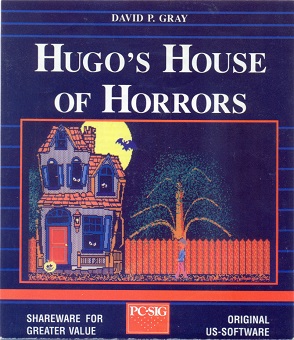
Hugo's House of Horrors is a parser-based adventure game designed by independent software developer David P. Gray and published as shareware in 1990. The game follows the character Hugo as he searches for his girlfriend Penelope in a haunted house. To progress through the game, the player uses items and interacts with the environment to solve puzzles and access more rooms in the house. The gameplay was inspired by Leisure Suit Larry in the Land of the Lounge Lizards. Hugo's House of Horrors was praised for its environment and atmosphere, but it was criticized for its plot and visual design. It was followed by two sequels: Hugo II, Whodunit? and Hugo III, Jungle of Doom!, and a spin-off first-person shooter game, Nitemare 3D.
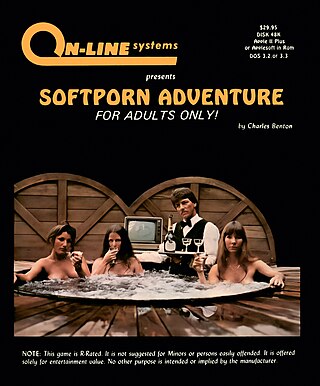
Softporn Adventure is a comedic, adult-oriented text adventure game produced for the Apple II in 1981. The game was created by Charles Benton and released by On-Line Systems, later renamed Sierra On-Line. Years later, Softporn Adventure was remade and expanded as Leisure Suit Larry series of adult-oriented video games, and the first entry in that series, 1987's Leisure Suit Larry in the Land of the Lounge Lizards, was a nearly direct graphical adaptation of Softporn Adventure. Another graphical version was released as Las Vegas for various Japanese computers in 1986 by Starcraft.

Leisure Suit Larry Goes Looking for Love (in Several Wrong Places) is the second game in the Leisure Suit Larry series of graphical adventure games, designed by Al Lowe and published by Sierra On-Line in 1988. Like its predecessor, Leisure Suit Larry in the Land of the Lounge Lizards, it was developed for multiple platforms, including MS-DOS, Atari ST and Amiga. It utilizes Sierra's Creative Interpreter (SCI0) engine, featuring 16-color EGA graphics and a mouse-based interface for movement. The story continues the exploits of Larry Laffer, who becomes stranded on a tropical island during an ill-fated vacation.

Leisure Suit Larry III: Passionate Patti in Pursuit of the Pulsating Pectorals is a graphical adventure game designed by Al Lowe and published by Sierra On-Line for DOS, Atari ST and Amiga in 1989 as the third entry in their Leisure Suit Larry series. The plot first follows series protagonist Larry Laffer, fresh from an abrupt divorce, as he combs through a tropical resort looking for love. After he meets the latest woman of his dreams, Passionate Patti, and leaves her to enter the wilderness, the player takes control of Patti to search for him.
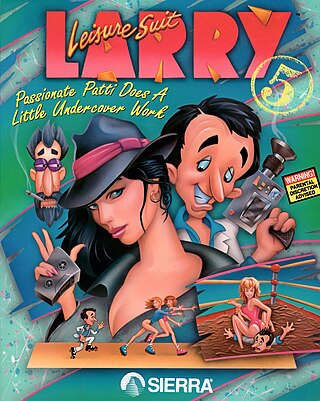
Leisure Suit Larry 5: Passionate Patti Does a Little Undercover Work is a graphical adventure game developed and published by Sierra On-Line for the Amiga, DOS and Macintosh computers in 1991. It is the fourth entry in their Leisure Suit Larry series and the first Larry title to have 256-color graphics and a fully icon-based interface. Being an (in)direct sequel to 1989's Leisure Suit Larry 3, its title is misleading, as there is no Leisure Suit Larry 4. The game is followed by Leisure Suit Larry 6 in 1993. It was re-released in 2017 on Steam with Windows support.

Leisure Suit Larry in the Land of the Lounge Lizards is a graphic adventure game, developed by Sierra On-Line, and published in 1987. It was developed for the PC, DOS, and the Apple II and later ported to other platforms, such as the Amiga, Atari ST, Apple IIGS, Macintosh, and Tandy Color Computer 3. It utilizes the Adventure Game Interpreter (AGI) engine. In 1991, Sierra released a remake titled Leisure Suit Larry 1: In the Land of the Lounge Lizards for PC DOS, Apple Macintosh, and Amiga. This version used the Sierra's Creative Interpreter (SCI) engine, featuring 256 colors and a point-and-click, icon-driven user interface.

Quest for Glory: So You Want to Be a Hero is a 1989 adventure game/role-playing game hybrid, designed by Lori Ann Cole and published by Sierra On-Line for MS-DOS. It is the first game in the Quest for Glory series, and has been credited for being a genre-defining game, as it tried to mix graphical adventure gaming with role-playing-like elements such as statistic building that would actually affect the ability to accomplish certain parts of the game. The game has a satirical and silly tone. Ports for the Amiga, Atari ST, and NEC PC-9801 were released in the early 1990s. A VGA remake, titled Quest for Glory I: So You Want to Be a Hero, was released in 1992 for DOS and later in 1994 for Mac OS.

Space Quest IV: Roger Wilco and the Time Rippers is a 1991 graphic adventure game by Sierra On-Line, and the fourth entry in the Space Quest series. The game was released originally on floppy disks on March 4, 1991, and later released on CD-ROM in December 1992 with full speech support; an Atari ST version was announced via Sierra Online's magazine, Sierra News Magazine, but was later canceled. The game sees players assume the role of Roger Wilco, who is thrust into a new adventure across time and space where he must thwart the plans of an old foe that is seeking revenge against him.
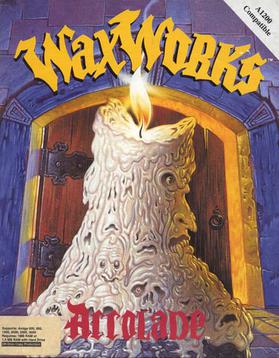
Waxworks is a horror-themed first-person dungeon crawl video game developed by Horror Soft and released in 1992 for Amiga, Macintosh, and DOS.

Police Quest: In Pursuit of the Death Angel is a 1987 police procedural adventure video game developed and published by Jim Walls and Sierra On-Line. Police Quest follows police officer Sonny Bonds as he investigates a drug cartel in the town of Lytton, California.

Altered Destiny is a graphic adventure game released by Accolade in 1990 for MS-DOS compatible operating systems and in 1991 for Amiga. The game was designed by Michael Berlyn and it uses a text parser interface. It is the second adventure game from Accolade and it uses the same engine as the first one, Les Manley in: Search for the King.
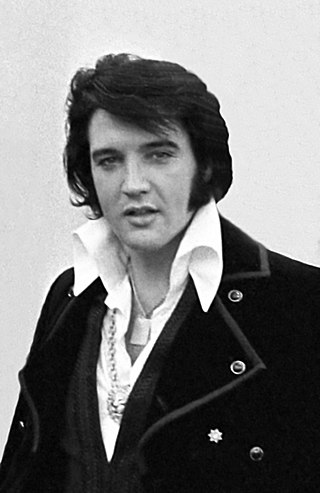
Sightings of the American singer Elvis Presley have been reported following his death in 1977. The conspiracy theory that Elvis did not die and instead went into hiding was popularized by Gail Brewer-Giorgio and other authors.

Hugo II, Whodunit? is a parser-based adventure game designed by independent software developer David P. Gray and published as shareware by Gray Design Associates in 1991. It is the sequel to 1990's Hugo's House of Horrors, and it was followed by Hugo III, Jungle of Doom! in 1992.

Leisure Suit Larry: Reloaded is a point-and-click adventure game released on June 27, 2013, by N-Fusion Interactive, Intermarum and Replay Games working with series creator Al Lowe and intellectual property holder Codemasters. The game is available for Microsoft Windows via Steam and GOG, OS X, Linux, Android and iOS. It is an enhanced remake of the 1987 Sierra On-Line adventure game Leisure Suit Larry in the Land of the Lounge Lizards. It is the second remake of this game, following the 1991 remake, which featured VGA graphics.

Les Manley in: Lost in L.A. is the second game in the Les Manley series of adult-themed graphical adventure games. It is often compared to the Leisure Suit Larry game series as both are adult-themed adventure games with a male protagonist. Different from its predecessor Search for the King which used a text parser, Lost in L.A. is a point-and-click adventure game. In 2020, Ziggurat Interactive acquired the publishing rights and re-released the game as a digital download on GOG.com.


















